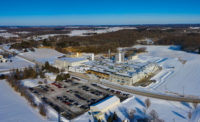Submitted by BioAir Solutions
A major Canadian dairy food processing plant recently found itself struggling with odor issues. The plant, which makes a wide range of cheese products for all of Canada, resides in a planned community; careful consideration was given regarding the balance between residential, industrial and commercial usages of the area. Problems with odor destabilized that balance, making local residents and businesses unhappy.
Plant management was interested in identifying the latest technology that would enable the facility to control the odors occurring within the plant, replacing an existing random-bed organic media biofilter system which was nearing the end of its life cycle. The plant operators attempted to improve the existing system with an alternate media, but their stringent odor removal requirements necessitated next-generation technology.
After careful consideration, the plant management team selected the environmentally-friendly technology developed by BioAir Solutions, a leading North American provider of biological odor and air emissions control technologies. BioAir has supplied a system proven to remove both organic and inorganic odorous compounds from municipal and industrial wastewater treatment plant and pumping station airstreams.
Treating wastewater odors without chemicals
Today more and more progressive companies are looking for a “green solution” to their wastewater treatment plant odors without using chemicals or activated carbon, systems which are costly to operate and maintain.
At the heart of the technology developed by BioAir is the EcoBase synthetic media, specifically designed to provide uniform and optimized mass transfer of odorous compounds under a controlled microenvironment. This enables the growth and proliferation of specific bacterial species that effectively remove wastewater treatment plant odors. The proprietary design of the EcoBase media includes engineered air flow channels to control mass transfer and eliminate plugging, and eliminates media density variations that often result in spotty performance of competing media types. EcoBase media has a life expectancy of over 20 years.
BioAir provided a total odor control solution to effectively treat eleven distinct emission sources within the cheese processing plant. These include the dissolved air floatation unit and a sludge tank, the biggest two odor sources in the plant. Additional odor sources included a screen well, the screen room, a caustic tank, a 105,000 gallon digester tank, the wet well building, two float storage and stabilization tanks, a 100,000 gallon conditioning tank, and a 300,000 gallon equalization tank.
In 2012, BioAir completed the startup of an EcoFilter EF82 biotrickling filter, which is 7.5 feet in diameter and 15 feet, 9 inches tall, inside one of the plant processing buildings. Though normally installed outdoors, this EcoFilter unit was installed inside to protect it from harsh Canadian winters and to provide ease of access to the operators. The compact unit included all necessary controls and equipment and a nutrient dosing system. Within a few weeks, the unit had removed more than 99% of H2S from the airstream. Over a year later, the system continues to work efficiently, making odors in the plant a thing of the past.
According to Louis le Roux, President of BioAir Solutions, this cheese processing plant was one of the first industrial applications for the company’s innovative technology after years of tremendous success in the municipal waste water treatment market.
Efficient and effective odor removal
“Removing odors from wastewater airstreams, whether in a municipal sewerage plant or an industrial setting, is what we do and do very well,” said le Roux. “This major global food processing company selected BioAir because of our ability to develop a comprehensive odor control solution with a technology that is efficient, effective and sustainable.”
BioAir Solutions develops new technologies and solutions to make biological odor and air emissions control more efficient, reliable and cost-effective for municipal and industrial wastewater treatment facilities.





